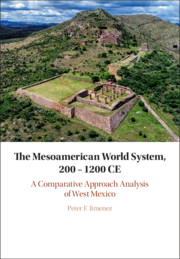Book contents
- The Mesoamerican World System, 200–1200 CE
- The Mesoamerican World System, 200–1200 CE
- Copyright page
- Dedication
- Contents
- Figures
- Tables
- Acknowledgments
- Abbreviations
- Chapter One West Mexico Coalesced
- Chapter Two The Comparative World-Systems Approach and Its Application to Archaeology
- Chapter Third The Regional Setting of West Mexico at 200 CE
- Chapter Four The Late Formative–Early Classic Period Transition 200/250–550 CE
- Chapter Five World-System Decentralization
- Chapter Six The Early Postclassic Period Transformation of West Mexico 900–1200 CE
- Chapter Seven West Mexico in the Mesoamerican World System
- References
- Index
Chapter Third - The Regional Setting of West Mexico at 200 CE
Published online by Cambridge University Press: 10 August 2020
- The Mesoamerican World System, 200–1200 CE
- The Mesoamerican World System, 200–1200 CE
- Copyright page
- Dedication
- Contents
- Figures
- Tables
- Acknowledgments
- Abbreviations
- Chapter One West Mexico Coalesced
- Chapter Two The Comparative World-Systems Approach and Its Application to Archaeology
- Chapter Third The Regional Setting of West Mexico at 200 CE
- Chapter Four The Late Formative–Early Classic Period Transition 200/250–550 CE
- Chapter Five World-System Decentralization
- Chapter Six The Early Postclassic Period Transformation of West Mexico 900–1200 CE
- Chapter Seven West Mexico in the Mesoamerican World System
- References
- Index
Summary
It is often overlooked that when Robert Weitlaner, Wigberto Jiménez Moreno, and Paul Kirchhoff teamed up with a group of advanced students in a research committee to undertake the survey of the vast territory of present-day Mexico and the adjacent area south to discern and classify the diagnostic traits and boundaries of the area, they submitted a summary report of preliminary results of a work in progress (Jáuregui 2008). The report Mesoamerica (Kirchhoff 1943) was prepared to elicit a thorough analysis and discussion with colleagues in order to enhance a second round of inquiry that was to follow. Kirchhoff expresses in the essay that he is “eager for suggestions concerning the best way to continue this study” (1943: 107, translation by the author), along with a petition for additional research which might have a bearing on the inquiry. The consultation and review Kirchhoff and the committee anticipated never occurred. Mesoamerica as conceived in this brief account was promptly assumed, promoted, and taken for granted (Jáuregui 2008). Half a century later, however, it has begun to receive both the scrutiny and the discussion originally sought by Kirchhoff. Most recently, this stems from the inadequate definition of its northernmost limits where Mesoamerican ideology along the Sierra Madre Occidental has been documented by ethnography (e.g., Jáuregui 2008, 2017; Sociedad Mexicana de Antropología 1990).
- Type
- Chapter
- Information
- The Mesoamerican World System, 200–1200 CEA Comparative Approach Analysis of West Mexico, pp. 29 - 41Publisher: Cambridge University PressPrint publication year: 2020



